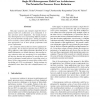Free Online Productivity Tools
i2Speak
i2Symbol
i2OCR
iTex2Img
iWeb2Print
iWeb2Shot
i2Type
iPdf2Split
iPdf2Merge
i2Bopomofo
i2Arabic
i2Style
i2Image
i2PDF
iLatex2Rtf
Sci2ools
MICRO
2003
IEEE
2003
IEEE
Single-ISA Heterogeneous Multi-Core Architectures: The Potential for Processor Power Reduction
This paper proposes and evaluates single-ISA heterogeneous multi-core architectures as a mechanism to reduce processor power dissipation. Our design incorporates heterogeneous cores representing different points in the power/performance design space; during an application’s execution, system software dynamically chooses the most appropriate core to meet specific performance and power requirements. Our evaluation of this architecture shows significant energy benefits. For an objective function that optimizes for energy efficiency with a tight performance threshold, for 14 SPEC benchmarks, our results indicate a 39% average energy reduction while only sacrificing 3% in performance. An objective function that optimizes for energy-delay with looser performance bounds achieves, on average, nearly a factor of three improvement in energy-delay product while sacrificing only 22% in performance. Energy savings are substantially more than chip-wide voltage/frequency scaling.
Hardware | Heterogeneous Multi-core Architectures | MICRO 2003 | Objective Function | Tight Performance Threshold |
| Added | 05 Jul 2010 |
| Updated | 05 Jul 2010 |
| Type | Conference |
| Year | 2003 |
| Where | MICRO |
| Authors | Rakesh Kumar, Keith I. Farkas, Norman P. Jouppi, Parthasarathy Ranganathan, Dean M. Tullsen |
Comments (0)

